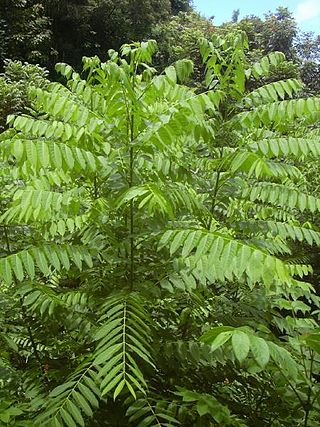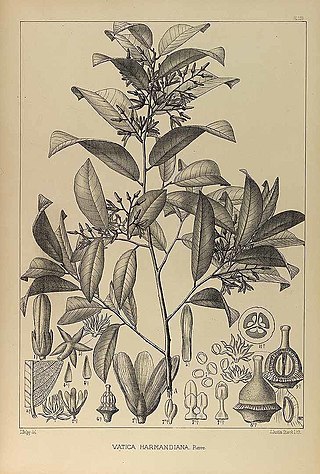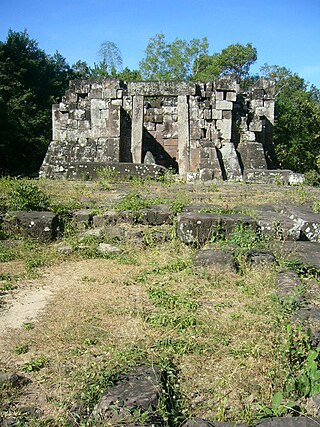
Cedrela odorata, commonly known as Spanish cedar, Cuban cedar, or cedro in Spanish, is a commercially important species of tree in the chinaberry family, Meliaceae native to the Neotropics.
Hopea altocollina is a tree in the family Dipterocarpaceae, native to Borneo. The specific epithet altocollina means "high hills", referring to the species' habitat.

Hopea beccariana is a species of tree in the family Dipterocarpaceae. It is named for the Italian botanist Odoardo Beccari.
Hopea griffithii is a tree in the family Dipterocarpaceae. It is named for the British doctor and naturalist William Griffith.
Hopea latifolia is a tree in the family Dipterocarpaceae. The specific epithet latifolia means "wide leaf".
Hopea micrantha is a tree in the family Dipterocarpaceae. The specific epithet micrantha means "small flower".
Hopea pedicellata is a tree in the family Dipterocarpaceae. The specific epithet pedicellata, refers to the species' prominent pedicel.
Hopea pentanervia is a tree in the family Dipterocarpaceae, native to Borneo. The specific epithet pentanervia means "five-nerved", referring to the species' five pairs of leaf veins.
Hopea sangal is a tree in the family Dipterocarpaceae. It is native to tropical Asia.
Hopea semicuneata is a tree in the family Dipterocarpaceae. The specific epithet semicuneata means "half wedge-shaped", referring to the leaf base.

Mangifera odorata, commonly known as kwini, huani, or Saipan mango, is a species of plant with edible fruit in the family Anacardiaceae. It is similar to the related mango but is characterized by a strong turpentine-like smell on the skin and fibrous flesh. It is native to tropical Southeast Asia, but its exact original native range is unknown because it is only known from cultivated specimens and is believed to be a hybrid of Mangifera indica and Mangifera foetida. It is grown throughout Southeast Asia, from peninsular Thailand, to Malaysia, Indonesia and the southern Philippines. It has also been occasionally cultivated in southern Vietnam and the Marianas Islands.

Vatica harmandiana, also known by the synonym Vatica cinerea, is a species of plant in the family Dipterocarpaceae. It is a smallish tree native to Southeast Asia. It is the most common plant species in certain types of mature woodland habitat within its range and is furthermore common in disturbed secondary forests covering much of its range, nonetheless it was considered, along with most Dipterocarpaceae, to be endangered by the IUCN between 1998 and 2017. It is usually not commercially harvested except for local use.
Dipterocarpus dyeri (Khmer: rôyiëng, chhë tiël pruhs, chhë tiël th'nô:r, local name Kompong Thom: chhieutiel chgor, name used for commercial timber and the group of trees harvested for such: keruing, Vietnamese: Dầu Song Nàng, is a species of tree in the family Dipterocarpaceae found in Myanmar, Thailand, Peninsular Malaysia, Cambodia, Vietnam, and northwestern Borneo. The tree is found in rain forest and lowland semi-evergreen dipterocarp forests, an alternative habitat description is mixed dense forests of the plains, mainly among rivers and valleys. The tree is a climax or late successional species, which in some secondary forests forms relatively young pure colonies. The conservation status is based on rates of habitat loss, the major threat to the taxa, though in Vietnam it is cited as having a less threatened conservation status of Vulnerable.

Nang Ta-khian is a female spirit of the folklore of Thailand. It manifests itself as a woman that haunts Hopea odorata trees. These are very large trees known as Ta-khian (ตะเคียน) in Thai, hence her name.

Belief in ghosts in Thai culture is both popular and enduring. In the history of Thailand, Buddhist popular beliefs intermingled with legends of spirits or ghosts of local folklore. These myths have survived and evolved, having been adapted to the modern media, such as Thai films, Thai television soap operas, and Thai comics.

Phu Phan National Park is a national park in Sakon Nakhon and Kalasin provinces, Thailand. This isolated park covers a wide jungle area in the Phu Phan Mountains of Isan.

Dipterocarpus baudii is the accepted name of a tropical forest tree species in the family Dipterocarpaceae; there are no known subspecies.
Hopea cernua is a tree in the family Dipterocarpaceae. The specific epithet cernua means "slightly drooping", referring to the flowers.
Hopea treubii is a tree in the family Dipterocarpaceae, native to Borneo. It is named for the Dutch botanist Melchior Treub.













